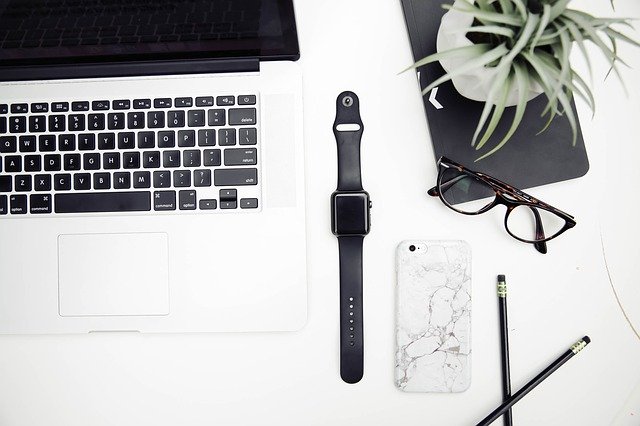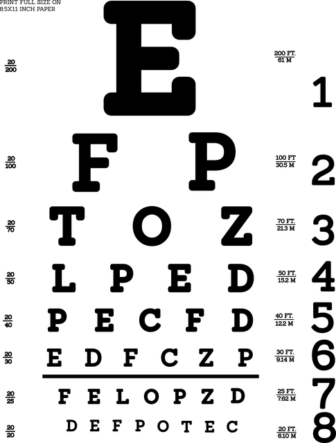
Myopia runs on one side of my family, so I have one regular eye and one very nearsighted eye. As a result, from time to time I end my calendar year with a trip to the eye doctor and numerous prayers that my eye sight has not gotten worse through the inevitable poor eye hygiene habits that are so common to contemporary twenty-first century living: long hours of screen time that result in eye strain, uneven amounts of nutrients which support eye health, and insufficient time outdoors doing activities that do not require continuous focusing on close objects. The necessity of a vision check for changes means a bit more than just whether I will need pay for a new set of glasses. It is an opportunity to see where the big picture is being missed due to these poor habits that are common with today’s lifestyle.

[Pixabay]
The expression, “hindsight is 20/20“, refers to the reality of knowing the right answer or seeing clearly what a situation happens to be after the fact. If we walk out into the street without checking to see that it is safe to do so and get hit by car, then looking back it will seem clear that perhaps checking in both directions before going into the street might have been the better choice.
These situations happen all the time. Think of car accidents, falls from bumping into something while trying to walk and send a text, or trying to read a text while moving. One current car commercial reflects the frequency of this happening as a reason to purchase a car with rearview camera to avoid hitting a completely oblivious pedestrian wearing earbuds who checks his phone while walking through a city environment.

[Pixabay]
Sitting in the ophthalmologist’s chair as he examines the arteries in the back of my eyes for health issues, such as eye stroke, diabetes, high blood pressure, and risk factors for heart disease gives me time to think about how myopia can affect other parts of life.
As we enter the year 2020, I look around at the proliferation of screens that occupy prime real estate in our very existence. Smart TVs, smartphones, and video doorbells thrive in a world where connectedness relies more on technology than conveying a message in person. Older devices, such as a landline telephones for phone calls or the use of physical correspondence such as letters, now appear quaint or old-fashioned or myopic.
While myopia is common, one article linked an increased use of devices with screen time among the young to a possible increased likelihood of developing myopia. I would love to see such a study run now, at the start of a new decade where the use of smartphones flourishes, and where video gaming commands sufficient respect to be a potential add to the 2024 Summer Olympics. Does focusing on the small screen and objects closely reflect a similar societal shift from the larger picture to just what exists in our immediate frame of reference?
As myopia is a defect, it makes sense that another meaning is having a close or narrow point of view. Being nearsighted means that anything far away is blurred or unclear. This lack of clarity in physical vision can appear in the larger societal lens as a lack of knowledge of what really matters for the individual or society on the large scale.
One prime lesson would be the start of World War I. Triggered by one act, the assassination of Austrian Archduke Ferdinand in Sarajevo, the ripple effect of a countries choosing to side with Austria-Hungary or Serbia quickly evolved into what would become a major series of conflicts which lasted over four years.
The small picture was the purpose behind the assassination: to free territory from the Austro-Hungarian empire. The larger picture broadened into a playground fight with other kids jumping in to help their friends. The myopic point of view does not consider the long-term consequences of actions taken in haste even when they do not appear to be hasty actions at the time. Rationalization does not substitute for the reflection that distance brings.
Likewise, the condition of hyperopia or farsightedness on a societal level permits a type of perceived ignorance of small problems in favor of addressing the larger scale or long-term issues. The assassination of Archduke Ferdinand was seen as a small step that would lead to a greater good; the additional small steps or ripples that later occurred were not considered as factors to achieving the ultimate good of rectifying a perceived wrong committed by the Austro-Hungarian empire.
Farsightedness is considered an overall asset on a larger scale when used in a manner that reflects consideration of all potential issues in planning for the future. Forward-thinking leaders often receive praise for making choices that will improve a situation years or even decades later such as planning a city close to waterways for convenient trade access or proactively working with other leaders to build alliances for long-term political, social, and economic stability on a global level.
Despite the perceived benefits from hyperopia as farsightedness on a societal level, the reality remains that too much or too little change in the visual acuity field deviates from the norm: 20/20 vision. For years, I thought that the term meant the best vision. Now, I see it as more “balanced” rather than the optimal or perfect vision.

[Pixabay]
While in a doctor’s office reading the eye chart, the test is on the clarity of vision at a distance of 20 feet (6.096 meters); however, over time the term “20/20” has been used to indicate a state of intense reflection in a two-album set (Justin Timberlake), an originally conceived in-depth television news program (20/20), and acknowledging a situation clearly.
The balance of seeing the present for what it is, without peering too far down the road into the future, or staring so deeply into one tiny speck of dust that lies on the edge of one’s vision means an increased ability to focus without stress. One major symptom of both myopia and hyperopia is headaches. The strain to see things close when it aches to do so or the strain to see things far away when it is more natural to see things up close creates an imbalance.
The body sends up a warning via headaches. As a child, this was the signal to head to the eye doctor and get fitted for glasses. For adults who tire of glasses or contacts, there is corrective surgery;however, there are risks. Glasses as a device are not only functional, but a fashion statement, for some sexy or a fetish.
Regardless of the corrective measure used, it comes down to an acknowledgement that perfection in the natural world is rare. We each have flaws and the very existence of visual conditions such as nearsightedness and farsightedness confirms the need to adapt beyond what we consider to be a regular or normal point of view. Just saying the year “2020” reminds me verbally of this image of perceived perfection.
I consider where my myopic eye needs to look a bit farther out than what is comfortable. I squash my envy of those who have 20/20 vision or even 20/40 for not needing to have glasses or contacts to bring reality into focus. I remind myself to take a break from the massive screen time that dominates my life, to keep eating my greens which support eye health, and to go outside more and just play. After all, it works for kids.
The Wild Hunt always welcomes submissions for our weekend section. Please send queries or completed pieces to eric@wildhunt.org.
The views and opinions expressed by our diverse panel of columnists and guest writers represent the many diverging perspectives held within the global Pagan, Heathen and polytheist communities, but do not necessarily reflect the views of The Wild Hunt Inc. or its management.
The Wild Hunt is not responsible for links to external content.
To join a conversation on this post:
Visit our The Wild Hunt subreddit! Point your favorite browser to https://www.reddit.com/r/The_Wild_Hunt_News/, then click “JOIN”. Make sure to click the bell, too, to be notified of new articles posted to our subreddit.
